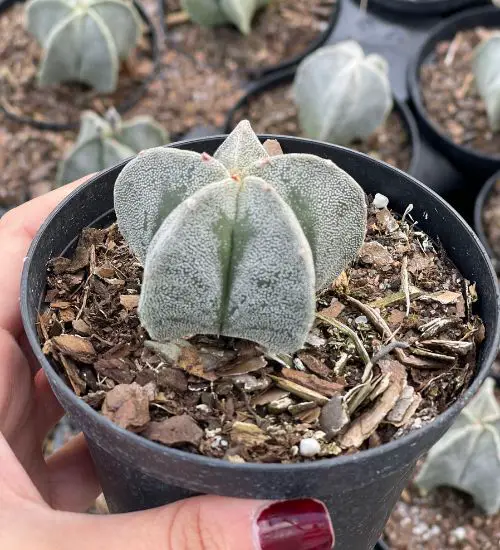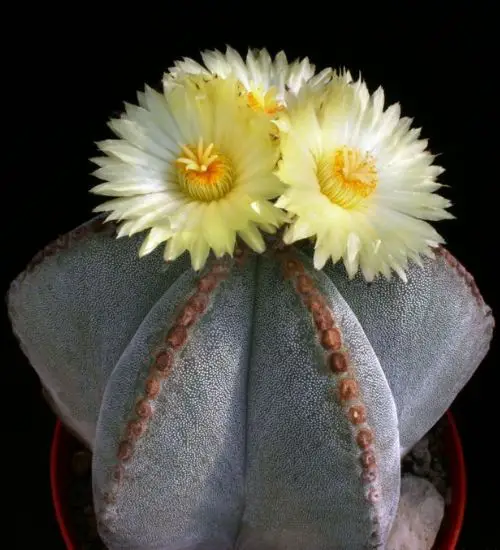Sun: full sun to partial shade
Water: Typical water needs for a succulent
Temperature: Zone 10a from 30° F to 35° F (-1.1 ° C to 1.7° C)
Winter Survival: Not cold hardy
Propagation: seeds
Flower: in the summer
Flower Type: Yellow, white or cream
Toxic: Generally non-toxic to humans and animals
Dormant: winter
Space Requirement: Indoors & Outdoors
Common Problems: Plants may rot if overwatered, pests
Where to buy Astrophytum myriostigma ‘Bishop’s Hat’?
Basc Care for Astrophytum myriostigma ‘Bishop’s Hat’
Watering
You can water your succulent more than often in extreme conditions but make sure that the soil is completely dry before watering your succulent again.
One simple tip for you is that you can use some online apps to check the soil status before you go water your succulents. I would recommend the ThePlantsCheck app, it has some nice features there.
Fertilizing
Only feed this succulent during its active growing seasons which means winter. Use the right fertilizer applied in the right amounts. Applying half-strength balanced fertilizer every month or so is recommended for optimal results.
Do not fertilize during winter as the plant is dormant.
Sun & Location Requirements for "Astrophytum myriostigma ‘Bishop’s Hat’"
Astrophytum myriostigma ‘Bishop’s Hat’ needs full sun to partial shade in order to thrive. While this variety needs plenty of bright light, it is important not to place it in direct sunlight for extended periods of time as this can cause damage or scorching to the leaves and stems. A shadier spot with indirect light could be just what Astrophytum myriostigma ‘Bishop’s Hat’ needs.
Astrophytum myriostigma ‘Bishop’s Hat’ is not cold hardy and does not survive in freezing conditions. However, there are certain strategies that can be used to help the plant thrive despite the chill of winter. Proper drainage and insulation are essential for succulent X during periods of extreme cold. Placing a layer of mulch or gravel on the soil around the plant can also help keep it warm.
Any succulents in the group will need a medium space to grow. You can place your pot at your table or window. Since this plant needs more space than mini succulents, you should consider do not plant them together with other succulents/plants.
Astrophytum myriostigma ‘Bishop’s Hat’ also benefits from some indirect light throughout the day as well, so make sure you give it enough space to soak up light without becoming too exposed to heat.
Propagation
Growing Astrophytum myriostigma ‘Bishop’s Hat’ from seeds is an easy and economical way to produce more plants. Identify a healthy seed by its plumpness, dark color and slightly sticky texture. Once the potting mix has been pre-mixed with well-draining soil, sow the seeds evenly and press lightly into the surface. To ensure germination, keep the container in bright but indirect light and mist the soil gently with a spray bottle.
Toxicity

Astrophytum myriostigma ‘Bishop’s Hat’ is generally non-toxic to humans and animals. However, the plant may contain certain toxins which can cause mild skin irritation if it is ingested or comes in contact with skin. Therefore, it is important to keep the plant away from children and pets for safety reasons.
Pests and Diseases
Astrophytum myriostigma ‘Bishop’s Hat’ can be affected common pests and diseases like most of the other succulents such as mealybugs and scale insects.
If you do spot any of pest signs, you can treat your succulent using below methods.
- Mealybugs: quarantine, clean infected plants, soapy water.
- Scale insects: quarantine, clean infected plants, soapy water.
Besides that, to prevent serious health issues from happening, keep your succulent in a well-ventilated area and check it regularly for any signs of pests or health problems.


